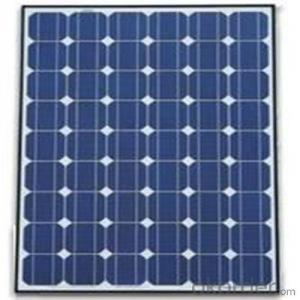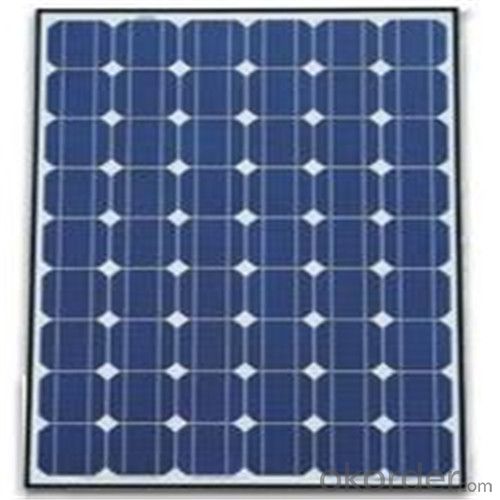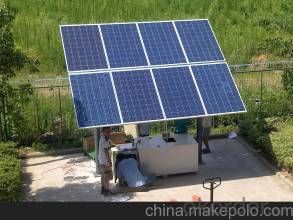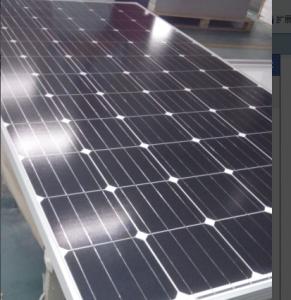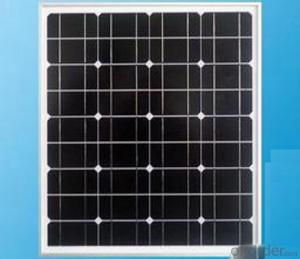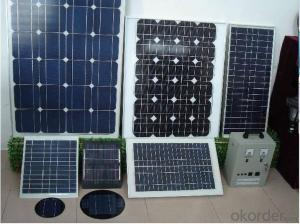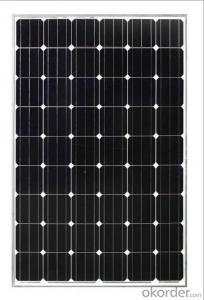36V 220W CPV Solar Panels - Monocrystalline PV Module with CE FCC Approved
- Loading Port:
- Tianjin
- Payment Terms:
- TT OR LC
- Min Order Qty:
- 1000 watt
- Supply Capability:
- 10000 watt/month
OKorder Service Pledge
OKorder Financial Service
You Might Also Like
Specification
Basic Info.
Model NO. | SPP-JT220W 230W 240W 250W | Material | Monocrystalline Silicon |
Peak Power Pm | 220W 230W 240W 250W | Max. Power Voltage Vmp | 18V(12V),27V,30V,36V(24V) |
Max. Power Current Imp(a) | 11A,6.38A,6.66A,6.94A | Dimensions(L*W*T)/ Weight | 1650*992*35mm/19.0 Kgs |
Front Cover(Material/Thickness) | Low-Iron Temperd Glass/3.2mm | Frame(Material/Collor) | Anodized Aluminum Alloy/Silver |
Junction Box Protection Degree | IP65 | Warranty:Output Power | 10 Years 100%, 20 Years 90% |
Product Certification / Standard | TUV,CE,RoHS,FCC,PSE/(IEC61215&IEC61730) | ISO Certification
| ISO 9001:2008 |
Export Markets | Global |
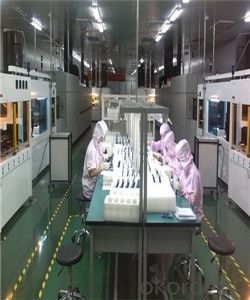
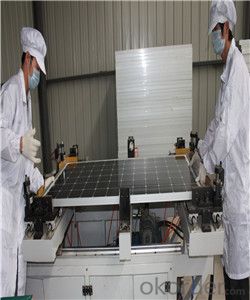
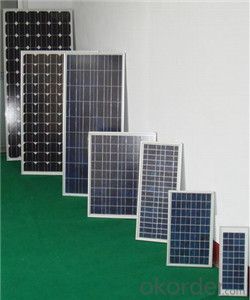
Additional Info.
Trademark:CNBM
Packing:Carton and Pallets
Standard:CE, ROHS, TUV, IEC61215, IEC61730
Origin:China
HS Code:8541409000
Production Capacity:10000PCS/Month
Product Description
Usage:
Take the solar panel under sunlight, the solar panel convert the sunlight into DC electricity
The electricity can be used directly or stored in battery for mobile phone charging, LED lighting, TV sets, fans, refrigerator and can changed to be AC power by inverter
Advantage:
The solar panel is green energy supply, markets supported by all country's governments
Warranty and long Life-time(for example):
100W after 10 years is still 100W
100W after 20 years is 90% 90W
100W after 30 years is 80% 80W
Function:
DC electricity providing
AC electricity providing by connecting with inverter
Battery power charger
LED and loading power supply
Accessories and material:
solar cells, tempered glass, EVA,TPT, aluminium alloy frame, connector box, shunt diode, 5m double wire
carton package, Logo(if necessary), bar code(if necessary), solar panel specification back label
Agent Support: Company Overseas Department
After-sale Service: Company After-sale Service Center
220W 230W 240W 250W polycrystalline solar PV panel performance and specification:
Parameters | SPP-JT220W | SPP-JT230W | SPP-JT240W | SPP-JT250W |
Peak power Pm(W) | 220±3% | 230±3% | 240±3% | 250±3% |
Open circuit voltage Voc(V) | 44.6 | 44.6 | 44.6 | 45.3 |
Max. power voltage Vmp(V) | 36.0 | 36.0 | 36.0 | 36.5 |
Max. power current Imp(A) | 6.11 | 6.38 | 6.66 | 6.94 |
Short circuit current Isc(A) | 6.60 | 6.89 | 7.19 | 7.49 |
Solar cells Efficiency | 15.1% | 15.9% | 16.5% | 17.1% |
Model efficiency | 13.5% | 14.0% | 14.67% | 15.27% |
fill factor | ≥73% | |||
Dimensions(L*W*T)/ Weight(kgs) | 1650*992*35mm/19.0 kgs | |||
solar cell / No. of cells and connections | Poly crystalline silicon 156*130*0.19mm/72pcs in series | |||
Front cover(material/thickness) | Low-iron temperd glass/3.2mm | |||
Encapsulant(material) | Ethylene vinyl acetate(EVA) | |||
Frame(material/collor) | Anodized aluminum alloy/silver | |||
Junction box protection degree | ≥IP65 | |||
Cable /Cable connector Model | PV1-F 1×4.0mm2×900mm/ MC4 | |||
STC | Irradiance:1000W/m2,Cell temperature:25ºC,AM:1.5 | |||
Max. static load ,front(e. g .,snow/wind) | 2400Pa | |||
Max. static load ,back(e. g .,wind) | 2400Pa | |||
Max. hailstone impact (diameter/velocity) | 25mm/ 23m/s | |||
Max. over-current (A) | 10A | |||
Max. system voltage (V) | 1000V DC | |||
Application Class | Class A | |||
NOCT | 48±2ºC | |||
Operating temperature limits | -40ºC- +85ºC | |||
Coefficient current TK | 0.1%/ºC | |||
Coefficient voltage TK | -0.37%/ºC | |||
Coefficient power TK | -0.45%/ºC | |||
Life | ≥25 years | |||
Warranty | Output power: 10 years 100%,20 years 90% | |||
Product Certification / Standard | CQC,TUV,CE,ROHS,FCC,PSE/(IEC61215&IEC61730) | |||
Other Certification | ISO 9001:2008 | |||
- Q: How do solar panels affect the property's energy consumption?
- Solar panels can significantly reduce a property's energy consumption by harnessing sunlight to generate electricity. By converting sunlight into clean, renewable energy, solar panels can offset much of the electricity that would otherwise be drawn from the grid. This leads to lower energy bills and a decreased reliance on fossil fuels, ultimately resulting in a more sustainable and eco-friendly energy consumption for the property.
- Q: Can solar panels be damaged by birds or other animals?
- Yes, solar panels can be damaged by birds or other animals. Birds may build nests under the panels or peck at the wiring, leading to potential system malfunctions. Similarly, other animals like squirrels or rodents may chew on the wires or cause physical damage to the panels. It is advisable to take preventive measures to protect solar panels from such animal interference.
- Q: I jotted down some notes for my Technology and Architecture class and I'm trying to figure out what i meant when i said 'Treated with gases at extremely high temperatures.' I have NO idea what I was talking about :) Im trying to figure out if what I am talking about is about Silicon, Polychristaline, or a Solar Cell/Panel.
- Some steps in making semiconductors use gases at very high temps, and solar cells might.
- Q: Pretty much, can solar panel's support the entire houses electrical needs generally, because I know sometimes the owner's can sell unused electricity back, any ideas or any ideas on how much the average home uses in kWh
- Solar okorder
- Q: Can solar panels be installed on water pumps?
- Yes, solar panels can be installed on water pumps. Solar-powered water pumps are a great alternative to traditional pumps as they harness energy from the sun to power the pumping system. This not only reduces reliance on fossil fuels but also makes these pumps more versatile and suitable for remote areas where electricity may not be readily available.
- Q: We are thinking about useing solar panels for our house.Does anyone know about solar panels? If so could you please tell me some information on them,and the cost for a home,to install them.
- solar panels are device that convert sun energy into electric energy by physic and chemical effect.solar panels price is high,but you will save your late electricity bill,it is cost effictive.
- Q: I am looking to wire in some solar panels into my home. I already have plenty of wiring, and some solar panels around. I just need to know what I need to do to wire them into my home so I can lower my electric bill. This past month it was six hundred dollars.Can someone direct me to some information, or tell me how without telling me to hire some guy to come out to charge me thirty thousand dollars to install two or three thousand dollars worth of equipment?
- The essentials are to connect the panels in a configuration that matches the inverter. My system has twenty 24 volt panels in series, to an inverter that wants to see 480. They could have been in any series-parallel configuration to match an inverter that used different voltage. I chose the high voltage route to reduce IR losses in the connections. The proper inverter is essential on grid connected systems. It must be able to disconnect from the grid if grid power fails, and to come back on line automatically, and in phase. There has to be a fused disconnect between the panels and the inverter. When connecting to the grid, another fused disconnect is required. My power company was very specific about acceptable switches. Just using a good brand doesn't hack it. Lots of good info on solar panels in the green search box above on this page.
- Q: Are solar panels safe for the environment?
- Yes, solar panels are safe for the environment. They generate electricity using sunlight, which is a renewable and clean energy source. Solar panels produce no greenhouse gas emissions, air pollution, or waste materials during operation. Additionally, they do not deplete natural resources, as sunlight is an abundant and infinite source of energy.
- Q: How do solar panels affect my electricity bill?
- Solar panels can significantly reduce your electricity bill by producing clean and renewable energy from the sun. By generating your own electricity, you can offset the amount of power you need to purchase from the grid, resulting in lower monthly bills. Additionally, if your solar panels generate more electricity than you consume, you may even receive credits or payments from your utility company.
- Q: Im doing this project on Solar panels and im not so sure what they are!some questions i have are who invented them and what were they invented? If u could know anything on Solar Panels i would love to hear it. Thanks!!!!!!!!!!!!!!!!!!!!!
- Solar Power. There is no denying it, solar power works. Not only is it energy efficient, it is also safe and extremely clean. Whether it may be for a home, business or a community, there are no limits to the energy that the best solar panels are able to offer.It is a guarantee that once this medium is applied, you would easily slash your greenhouse gas emissions and electricity bill.
Send your message to us
36V 220W CPV Solar Panels - Monocrystalline PV Module with CE FCC Approved
- Loading Port:
- Tianjin
- Payment Terms:
- TT OR LC
- Min Order Qty:
- 1000 watt
- Supply Capability:
- 10000 watt/month
OKorder Service Pledge
OKorder Financial Service
Similar products
Hot products
Hot Searches
Related keywords
